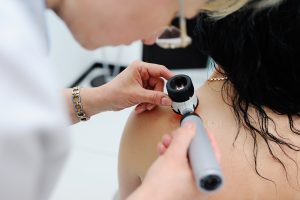A systematic review to evaluate whether dermoscopy can be used accurately and effectively in primary care to improve the timely diagnosis of melanoma
Start Date Oct 2017
Code C2-C
Status Completed
Introduction
 Worldwide, malignant melanoma is the 15th commonest cancer with nearly 300,000 new cases of melanoma in 2018. Melanoma has one of the fastest rising incidence rates of any cancer, and among white populations, incidence has quadrupled over the last 30 years.
Worldwide, malignant melanoma is the 15th commonest cancer with nearly 300,000 new cases of melanoma in 2018. Melanoma has one of the fastest rising incidence rates of any cancer, and among white populations, incidence has quadrupled over the last 30 years.
Most skin lesions first present in primary care where distinguishing rare melanomas from benign lesions can be challenging. More accurate triage of suspicious pigmented skin lesions in primary care could lead to more prompt diagnosis of melanoma at earlier stages and improved outcomes, and reduce unnecessary biopsies and referrals. Dermoscopy improves diagnostic accuracy among specialists and is promoted for use by primary care physicians. However, when used by untrained clinicians, some studies suggest that accuracy may be no better than visual inspection; therefore, patients with suspicious skin lesions may have unnecessary referrals and excisions, or even inappropriate reassurance.
Aims & objectives
Our systematic review aimed to focus on the first presentation of suspicious skin lesions in primary care and whether dermoscopy and dermoscopy-related technologies, with suitable training, can be used accurately and effectively to triage suspicious skin lesions at this point in the healthcare pathway. We considered various types of dermoscopy technologies, including hand-held dermoscopy, computer-aided/digital dermoscopy devices, and novel tele-dermoscopy approaches (i.e. referral using electronic dermoscopy images or video). In addition, we searched for evidence on the diagnostic accuracy of dermoscopy, and on the practical challenges to implementing dermoscopy in primary care including: acceptability to patients and primary care clinicians, training requirements, and cost-effectiveness.
Methodology
This systematic review was conducted in accordance with the PRISMA guidelines, and the protocol was registered with PROSPERO (CRD42018091395) prior to conducting the review.
We searched the MEDLINE, EMBASE, Cochrane Central, CINAHL and SCOPUS databases using keywords related to dermoscopy, melanoma and primary care, without language restrictions, from 1st January 1990 to 31st December 2017.
We also manually searched reference lists of included studies. We included all types of study design as we anticipated that there would be few relevant randomised controlled trials (RCTs) or diagnostic accuracy studies performed in primary care, and we aimed to find additional qualitative evidence on barriers to the use of dermoscopy which may be found in non-RCT study designs.
We chose to start the search from 1990 as this was when the earliest dermoscopy-related research emerged. We considered published evidence from any international healthcare system and whether it could be interpreted and applied to primary care settings, including the extent to which data collected from specialist clinic settings could be applied to the lower-prevalence primary care population.
Outputs & impact
23 studies met the review criteria, representing 49,769 lesions and 3,708 PCPs, all from high-income countries. We found few studies set truly in primary care, and their outcomes were diverse. The findings suggested that dermoscopy, with appropriate training, was associated with improved diagnostic accuracy for melanoma and benign lesions, and reduced unnecessary referrals and excisions.
We concluded that dermoscopy has the potential to help primary care physicians triage suspicious lesions for referral, biopsy or reassurance. However, further evidence is needed on training and updating dermoscopy skills, as well as the patient acceptability and cost-effectiveness of implementing dermoscopy in primary care.
Next steps
In the short term we have started a scoping review of the evidence for the use of Artificial Intelligence technologies to aid in the triage of suspicious skin lesions in primary care settings. In the longer term, we are developing studies to provide evidence on the acceptability and cost-effectiveness of implementing dermoscopy in primary care.
Publications
- Jones OT, Jurascheck LC, Utukuri M, Pannebakker MM, Emery J, Walter FM. Dermoscopy use in UK primary care: a survey of GPs with a special interest in dermatology. Journal of the European Academy of Dermatology and Venereology, 2019, https://doi.org/10.1111/jdv.15614


